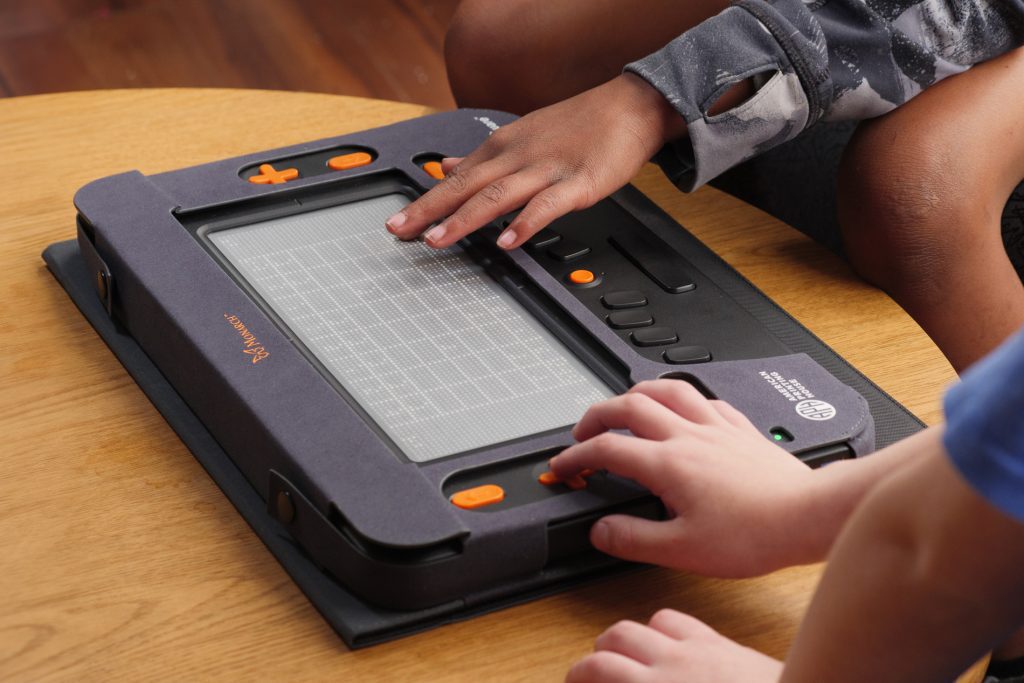Students and Teachers “Level Up” with the Monarch

Since the release of the Monarch, students and teachers everywhere have been exploring, learning, and training on this new piece of technology. While the Monarch itself is a revolutionary device, how is it actually affecting lives?
Dawn Wilkinson is an assistive technology teacher, who is blind, at the Kentucky School for the Blind. Her pupil, Addie, is an eighth-grade student who is also blind, and very passionate about the future of tech in the lives of blind individuals.
Dawn and Addie received their Monarch a few weeks ago and have since been training on the device. Dawn spends a lot of her own free time exploring the Monarch and gaining a better understanding of the device to ensure she can explain it in a way that is simple and attainable.
“We don’t want any of this to be intimidating,” said Dawn.
Addie is in the early stages of exploring her Monarch but is already thrilled by what she has found. From tactile graphics of cars to a Star Trek aircraft, she was shocked by how many graphics there really are available to her in the TGIL.
The format of controls and navigation on the Monarch have been familiar to both Dawn and Addie for a variety of reasons. Both were shocked by the similarities between the basic functions of the Monarch and the BrailleNote Touch. Both devices are powered by Humanware’s KeySoft Accessibility Suite, so a lot of the navigation tools, powerup messages, and general menu set-up is extremely similar. For many blind students like Addie who have been using BrailleNote Touch in their classrooms for years, this makes for an easy transition to the Monarch. Also, for many students like Addie, who love to play video games, the inclusion of a D-pad navigation is very exciting.
“I was excited, it’s just like a video game controller,” said Addie.
The most notable impact of the Monarch, for both Dawn and Addie, is the expansive library of tactile graphics. Addie recalled her recent standardized testing, where she was presented with an abundance of graphics she had never been exposed to before, making it impossible to complete the image-based questions.
“I can’t read those graphics,” said Addie. “I’m sure I did so bad on that test. No one deserves low test scores because they can’t look at the photos.”
Dawn has seen many students, including herself, with the same frustration. Tests where the image graphic is too complex to read, questions where the image is removed completely leaving the student with the phrase ‘photo has been omitted’ over a question that reads ‘based on the photo above,’ or simply a side note that says ‘if you cannot read the image, ask your teacher.’ The inability to complete problems on standardized testing due to lack of resources is an obstacle that many blind students face regularly. More exposure to tactile graphics can be game changing.
“The Monarch is going to bring tactile graphics to the forefront of learning. I am so glad to see tactile graphics get the recognition in education they need,” said Dawn.
“I can even fulfill my lifelong dream of feeling and learning the print alphabet,” said Addie.
Even outside of the classroom, tactile graphic access can help students who are blind pass an abundance of obstacles.
When considering the impacts of the Monarch and this kind of tactile exposure, Dawn said “this is going to give our kids the chance to shine,” to which Addie responded, “Yeah. It’s time for us to level up.”
Share this article.
Related articles

Connect the Dots Sets the Stage for The Dot Experience
Churchill Downs, Louisville Slugger Museum & Factory, Muhammad Ali Center, and many more are on a long list of attractions...
